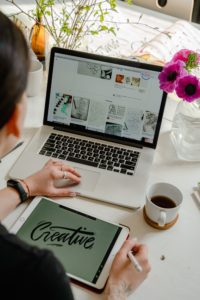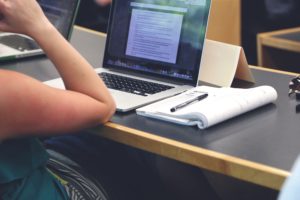Laura Hollinshead, Learning Technologist-Curriculum Development
We have collated some case studies of good practice across the institution, providing some ideas of the asynchronous activities which have been used successfully by others.
Podcasting
Within Nursing, podcasts have been used to respond to questions posed by students in an online form. This helps bring answers and questions together and provides a friendly personal voice, which can often be lost through text-based responses. It also provides a flexible way for students to access these resources and through releasing these on a regular basis the students know their questions are being responded to, encouraging more students to submit their own.

American Studies and Popular Music in Society produced a series of seven podcasts supported by PowerPoint slides, with embedded links to relevant documentary clips. Students are then given the opportunity to follow-up on anything via email, or in the weekly drop-ins scheduled via Collaborate.
How can I do this?
- Set up a Microsoft Form for students to submit their questions about their learning and send this link and instructions about the type of questions you would like students to focus on. The form can be set up to receive these anonymously if you feel this will help students to ask questions.
- Remember to set a deadline for this so you can then review the questions.
- Use Panopto to record your responses to the questions. You could consider creating PowerPoint slides with the questions on to help guide you through them.
- Make the recording available to students within Course Resources.
- Repeat this so students become familiar with submitting questions and listening to the podcast on a regular basis.
Setting online challenges
Journalism students have watched a video on how to create high quality images using their phones and then completed an ‘online challenge’ to post photographs for feedback. This presented the students with an opportunity to interact with each other whilst sharing their work and gathering valuable feedback.

In BA Dance, students have generated social media based challenges for our dance students (access examples via Instagram page or this example video).
How can I do this?
- Think of an engaging challenge which relates to students’ learning. This could be subject specific or relate to students sharing studying tips.
- Record a Panopto video to set out the online challenge.
- Create a discussion forum or Teams channel for students to share their work.
- Encourage other students to provide feedback on the shared work and do this yourself.
Engaging resources for students
Within Audio and Lighting Engineering, several engaging online resources have been provided for students to engage them whilst learning remotely. These include flexible learning opportunities, such as the Dante Certification Program (online learning and assessment audio networking), the Sound Gym audio ear training website, Soundvision and L’acoustics webinars for students to join or watch the recording and free membership to ‘Education and Bass’.

In Publishing and Creative Writing, a London-based voice coach recorded seven short videos for students, and these were then uploaded to Course Resources.
In Culinary Arts and Food Development, all students were introduced to APICbase, a culinary food management system, they were then subsequently given logins to work and develop systems online within tutorials.
How can I do this?
- Look for opportunities for generating new resources using experts who can create these remotely
- Are there free opportunities which students can take advantage of remotely? Such as via
- Take a look on the Repository in Panopto and Box of Broadcasts to find resources which can help engage your students in key areas of learning or study.
- Signpost students to these resources and help facilitate them working through these resources linking this learning back to other learning activities on their course.
Keeping it simple
Marketing and Logistics have found that keeping a simple approach has worked well and that moving online, using a combination of asynchronous and synchronous resources, has not negatively impacted the student experience. Students have enjoyed the flexibility of a recorded lecture, and the interaction with smaller groups on MS Teams. Email or 1-2-1 video consultation has been provided for further clarification of points is needed. There has also been more regular contact with their Greek collaborative partners, who have found the recorded material valuable and reported that their students have enjoyed the experience.

How can I do this?
- Think about how you can blend flexible opportunities to engage with those you can provide live. How can you ensure that student who cannot engage in live events do not miss out?
- What ways could help students to follow up on questions they may have? Should these be answered collectively as the answers could be useful to all students?
- Is there a way to make these experiences more personal? This is something which can be harder to provide at a distance and especially for those students who are unable to attend live events. Podcasts, recorded lectures and responses to questions or contributions posted by students can help to provide this.